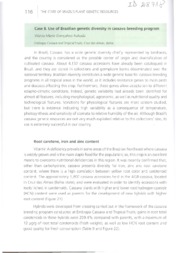Use of Brazilian genetic diversity in cassava breeding program.
Use of Brazilian genetic diversity in cassava breeding program.
Author(s): FUKUDA, W. M. G.
Summary: In Brazil, Cassava has a wide genetic diversity chiefly represented by landraces, and the country is considered as the possible center of origin and diversification of cultivated cassava. About 4,132 cassava accessions have already been catalogued in Brazil, and they are stored in collections and germplasm banks disseminated over the national territory. Brazilian diversity constitutes a wide genetic base for cassava breeding programs in ali tropical areas in the world, as it includes resistance genes to main pests and diseases affecting this crop. Furthermore, these genes allow adaptation to different edapho-climatic conditions. Indeed, genetic variability had already been identified for almost ali features, including morphological, agronomic, as well as nutritional quality and technological features. Variations for physiological features are more seldom studied, but there is evidence indicating high variability as a consequence of temperature, photosynthesis and sensitivity of stomata to relative humidity of the air. Although Brazil's cassava genetic resources are not very much exploited relative to the collections' size, its use is extremely successful in our country.
Publication year: 2009
Types of publication: Book sections
Unit: Embrapa Cassava & Fruits
Keywords: Genetic diversity, breeding, cassava
Observation
Some of Embrapa's publications are published as ePub files. To read them, use or download one of the following free software options to your computer or mobile device. Android: Google Play Books; IOS: iBooks; Windows and Linux: Calibre.
Access other publications
Access the Agricultural Research Database (BDPA) to consult Embrapa's full library collection and records.
Visit Embrapa Bookstore to purchase books and other publications sold by Embrapa.

